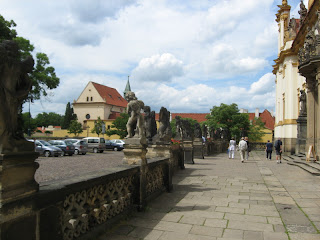A. Hot
B. Very hot
C. #!@+&%£ hot
If you guessed "hotter than C", you are correct.
 Only a few offices in the Generalate have A/C so most of us have to make do with a fan. I have a nice, black fan that was left by my predecessor in office. It is very nice to look at. It works well, except, that is, when it is hot. A couple of weeks ago on what was the hottest, most humid night of the year so far, I took the fan into my bedroom, plugged it in, turned it on and ... nothing. The extreme heat must have affected my brain because something made me think I could fix it on the spot. Fixing it involved first removing the six small screws holding the fan guard in place. The only screwdrivers I had available were the kind you use for eyeglasses and small appliances, but I was undeterred. For such small screws, they sure were tenacious! By the time I had unscrewed/cursed/yanked (pick one) the sixth one, I was drenched in perspiration. Now all I had to do was unscrew another dilly-dally, take off the whatchamacallit and finally remove the thingamabob. Now the important part—I put my hands on my hips, stared at the pieces and said, "Hmmm". Next, I tapped a few pieces with my finger, then started to put it all back together. When it came time to put the fan guard back on, I could see those six small screws defiantly mocking me so I decided to deal with them the next day. I plugged it in, turned it on, gave the blades a few whirls with my finger (DO NOT TRY THIS AT HOME, BOYS AND GIRLS!) and it finally began to work on its own. It did, however, voice its displeasure about having to work in such miserable conditions by emitting various shrieks and groans throughout the night.
Only a few offices in the Generalate have A/C so most of us have to make do with a fan. I have a nice, black fan that was left by my predecessor in office. It is very nice to look at. It works well, except, that is, when it is hot. A couple of weeks ago on what was the hottest, most humid night of the year so far, I took the fan into my bedroom, plugged it in, turned it on and ... nothing. The extreme heat must have affected my brain because something made me think I could fix it on the spot. Fixing it involved first removing the six small screws holding the fan guard in place. The only screwdrivers I had available were the kind you use for eyeglasses and small appliances, but I was undeterred. For such small screws, they sure were tenacious! By the time I had unscrewed/cursed/yanked (pick one) the sixth one, I was drenched in perspiration. Now all I had to do was unscrew another dilly-dally, take off the whatchamacallit and finally remove the thingamabob. Now the important part—I put my hands on my hips, stared at the pieces and said, "Hmmm". Next, I tapped a few pieces with my finger, then started to put it all back together. When it came time to put the fan guard back on, I could see those six small screws defiantly mocking me so I decided to deal with them the next day. I plugged it in, turned it on, gave the blades a few whirls with my finger (DO NOT TRY THIS AT HOME, BOYS AND GIRLS!) and it finally began to work on its own. It did, however, voice its displeasure about having to work in such miserable conditions by emitting various shrieks and groans throughout the night.Since that night, the fan has continued to operate admirably. Until last night, the second hottest night of the year. I was awakened several times during the night by its plaintive cries. Tonight promises to be even hotter. Will this be the night of the definitive sciopero?



